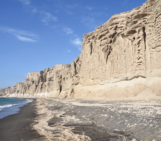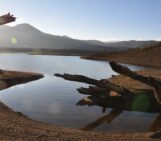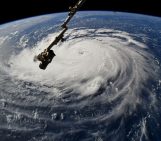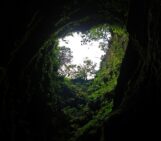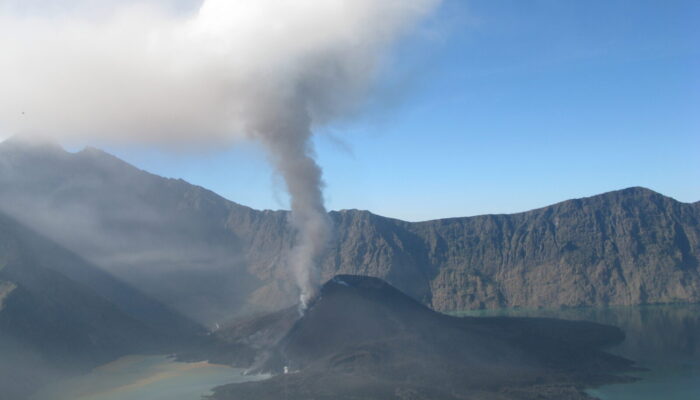
This Halloween, we turn our gaze from fictional haunts to the chilling, rigorous world of paleoclimatology. The paper by Hartmann et al. (2025), published on Climate of the Past, focuses on the implementation of external forcings in a regional climate model around the 1257 CE Samalas volcanic eruption. This paper can be quite the unsettling investigation, since it treats the Earth itself as a time machine of catastrophe.
The paper’s entire purpose is to pull back the shroud on one of history’s most dramatic, yet not-so-well understood, global shocks: the 1257 CE eruption of the Samalas volcano in Indonesia. Did you know that this one was the largest volcanic gas injections of the last seven millennia? Historical accounts and ice core data confirm that this event created a vast, invisible shield of sulfur aerosols high in the stratosphere, blocking sunlight, and plunging the Northern Hemisphere into a brutal cold spell, leading to the collapse of the Kingdom of Pamatan in Indonesia, widespread crop failures, famines, and societal upheaval across Europe, the Middle East, and Asia, a chilling preview of the centuries-long global temperature drop known as the Little Ice Age. The core motivation of this study? To stop guessing the effects and start modeling them with more precision.
The horror of the scale gap: Seeking high-definition ghosts
The study’s central, disruptive premise is that the standard Earth System Models are too spatially coarse to accurately capture regional climate extremes. This is the horror of the scale gap: global models only have a “grid” of about () per square. That average might look benign, but within that block lies the specific mountain range, the coastal zone, and the river delta where real societal collapse occurs. Coarse models average out the dangerous peaks and valleys and mask the localised climate shock that history records. You simply can’t capture a local haunting with a global picture.
To address this, the authors employ dynamical downscaling using the Regional Climate Model (RCM) COSMO-CLM at a much finer resolution. They are essentially upgrading the resolution of the ghost photo, which exposes the high-definition details of the Samalas eruption’s impact on the Eastern Mediterranean/Middle East (EMME), a region rich in historical significance and known to be extremely sensitive to climate shocks.
The blueprint of the time machine: Material and methods explained
To appreciate the findings, we must first understand the construction of this climate time machine, detailed in the paper’s methods section. This is where the scientists act as engineers of the past to define, with as much precision as possible, the environment and the forces at play.
The team begins by defining their window of investigation: the decade from 1255 to 1264 CE, a period long enough to establish a pre-eruption baseline and track the years of fallout. The 1257 event was so massive that it created the large crater, or caldera, known today as Segara Anak. More importantly for the climate, it injected immense quantities of sulfate aerosols into the atmosphere. The team uses a historical reconstruction of the Aerosol Optical Depth (a measure of how much visible light is blocked by atmospheric particles) to track this shield. The Aerosol Optical Depth sharply increased right after the eruption and remained elevated for several years, which confirms the immediate cause of the surface chilling.
The modeling itself is a two-step process: first, the global context is set by the coarse MPI-ESM-LR model, which calculates the atmosphere, ocean, land, and chemistry for the entire world at a resolution. This model provides the necessary boundary conditions, the global circulation pattern, for the regional model. Second, the fine detail is added by the RCM, COSMO-CLM. This model is the true engine of the study, zooming in to a resolution. Its sophisticated physics uses a Runge-Kutta scheme for time integration and a Tiedtke scheme for convection modeling, which therefore allows it to see the small-scale effects of mountains and coastlines.
The volcanic forcing induces a decrease in precipitation due to surface cooling, resulting in increased atmospheric stability and reduced evapotranspiration. Due to the increased complexity of potentially modified general circulation patterns caused by the surface cooling, the influence of the volcanic eruption on precipitation variability becomes less dominant after one to two years.[…] wrote the authors.
The most crucial step for the scientists was telling it what outside forces were pushing the weather around. The authors had to feed the model the biggest historical drivers of climate change, and they basically gave each one a personality based on how it worked. There was Volcanic Forcing, which acted like a jump scare: a huge, fast, short-lived shock to the system, mainly when the massive aerosol cloud from Samalas blocked out the sun. Then there was Solar Forcing, the flickering lantern, which simply tracked the changes in the Sun’s brightness, or its Total Solar Irradiance. Alongside that was Greenhouse Gas Forcing, or the slow, poisonous fog, representing the gradual, long-term chemical changes in the atmosphere from things like CO2.
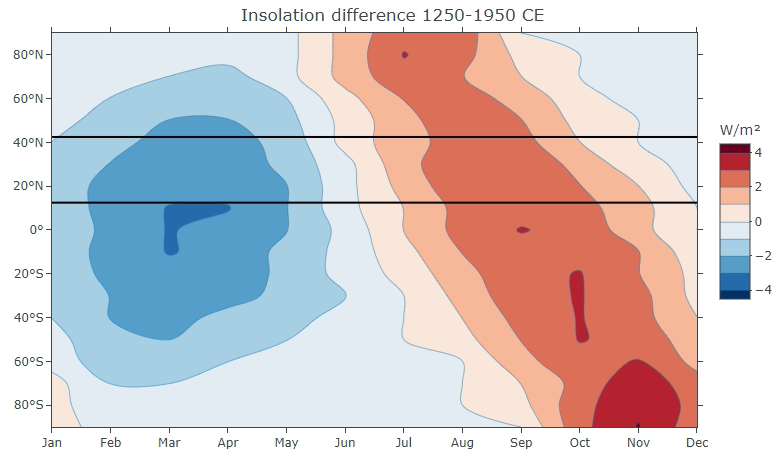
Figure: Insolation difference due to orbital forcing between the century of the Samalas eruption and present days (1250–1950 CE; own representation of data from Berger and Loutre, 1991 linearly interpolated). The study domain is between 12.5 and 42.5° N marked with horizontal lines.
Finally, they included Orbital Forcing, the deep-time haunting, which accounts for the vast, slow shifts in the Earth’s tilt and orbit that have been altering our seasons over thousands of years.
The innovation here is that instead of letting the regional model just absorb the averaged result of the global model, the researchers explicitly implemented each transient forcing directly into a regional model’s source code. In their paper, the authors state that
The higher resolution of CCLM, compared to the MPI-ESM-LR, allows for a more detailed depiction of topographic features, including coastlines and complex mountain ranges.
This means that when they ran the volcanic experiment the regional model’s radiation routine knew the exact amount of solar light to block at every grid square. This guaranteed the model saw the real ghost of the volcanic cloud, not just the global model’s blurry impression of it.
The findings: The volcanic jump scare and the ominous orbit
The paper’s results showed that two different things drove climate changes in the past: a sudden volcanic shock and the Earth’s slow, constant orbital shift. The volcano’s eruption was the biggest, fastest event. When scientists put the effect of the eruption (sulfate clouds blocking the sun) directly into their computer model, the temperature dropped sharply immediately afterward. This immediate, deep chill matched historical records and proved it was better to directly model this sudden event rather than letting a general global model guess its impact.
However, the quiet, subtle changes in the Earth’s orbit turned out to be the most important long-term driver. While the volcano was a two-year jolt, the way the Earth slowly moved around the sun over the centuries changed the seasons significantly. It caused much colder winters and springs, while summers and autumns became slightly warmer. So, the Earth’s long-term cosmic position acted like a “silent ghost,” having a slower, but more persistent and decades-long influence on the regional climate’s seasonal pattern than the dramatic, short-lived volcanic blast.
Lessons learned
The study critiques its own limitations, which is the hallmark of great science. The authors note the significant cooling trend that existed before the eruption (1255–1256), which prevents them from claiming the post-eruption cooling is statistically significant against natural climate variability alone. This is the scientific confession: without running ensembles (multiple simulations with slightly different starting points), they cannot definitively say the cooling they see is only due to the volcano, or if it’s partly due to the climate system’s own internal “mood swings.” This resource-based limitation is a clear roadmap for future transient runs: only then can the true signal of the “spectral shadow” of Samalas be definitively separated from the internal noise of the climate system.
The study also proves the importance of high resolution. The model captured two major temperature groups at the same time. This is called a bimodal distribution. It showed both the hot desert climate and the cooler Mediterranean climate. The finer map detail captured this complexity. It also made sure extreme temperatures were shown accurately. This is because the model better accounted for the effects of mountains.
Geoscientists and Halloween: Shared obsessions?
Why do geoscientists and Halloween have so much in common? They both share an obsession with the deep, dark, and eerie.
Geoscientists look for the invisible forces that shape our world. You name it: tectonic strain, silent subduction, the diffusion of gases in the atmosphere, and the faint, preserved signals in ice cores. Halloween is the one night we collectively celebrate and/or honour the things we can’t see. Geoscientists study Deep Time, a span so immense it makes human history feel like a fleeting candle flame; Halloween celebrates the ancient dead, the historical figures whose actions still echo in our myths and fears. The geological processes of erosion, continental drift, and volcanic outgassing are patient, relentless, and completely indifferent to human life. This unstoppable, massive power is far more terrifying than any fictional monster.
Hartmann et al.’s study is the quintessential Halloween geoscience piece: it brings a catastrophic, ancient spectral shadow to life in terrifying detail, and reminds us that the Earth’s inner fury and its cosmic relationship pose the most significant threat to our perceived stability. After all, the secrets of our future are buried deep in the history of our planet, and only meticulous, high-resolution science can make those ghosts walk among us.

